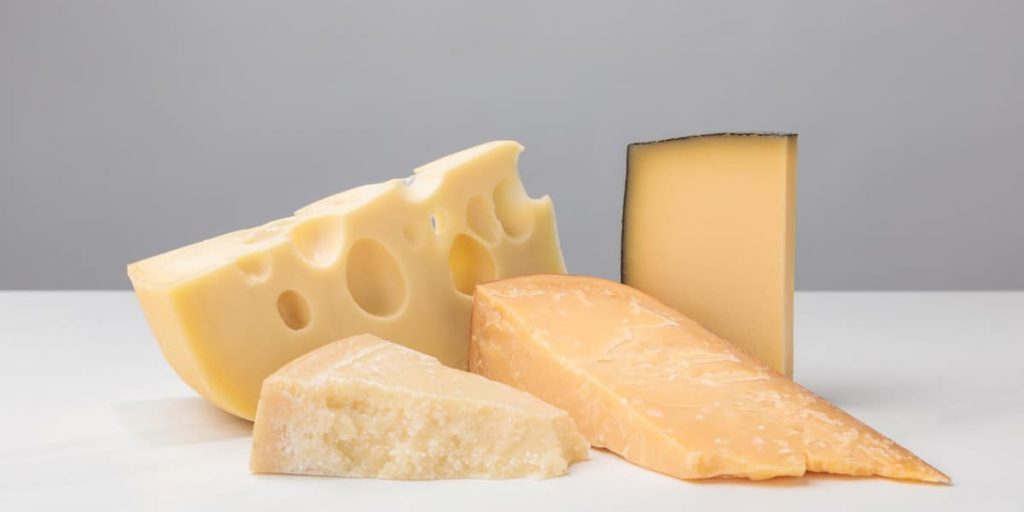If you’re a cheese lover like me, then I’m sure that you’ve been disappointed at some point when out of the blue, your favorite cheese is no longer available in stores. This can be especially frustrating if it’s hard to find cheese like Gruyere. But don’t worry, Gruyere has many substitutes, and we’ll tell you what they are and why they work in this blog post! An easy and delicious Pasta with a Gruyere cheese recipe is also included after the article!
What is Gruyère cheese?
A Gruyère is smooth it has won the world’s biggest cheese competition four times to date – and this alone makes it unique in the realm of cheese.
What is the secret of a good Gruyère cheese?
A Gruyère is a yellowish, slightly nutty taste cheese made from cow’s milk. This Swiss dairy product has been protected since 2001. The personality and flavor of the cheese are determined by how long it has been aging.
The flavor and the saltiness of cheese depend on many factors, but most importantly, how long it has been aged. The younger (5 months) varieties have a somewhat milder nutty flavor, while the older (up to 1 year) Gruyère cheeses taste more complex.
Where does it come from?
It got her name from the Swiss city of Gruyères and canton. This tiny, sculptural city is located on a hill 810 meters above sea level between the Swiss Alps and east. The village church and surrounding pastures silhouette the view of many cattle on a green field. It’s no surprise that many of Gruyères’ cows earn money from cheesemaking. Check out the cheese factory while you’re here, and don’t forget to see the castle built in the late 1200s.
Pro tip: Don’t forget about the Cailler chocolate factory, which is about ten kilometers away, if you’re a chocoholic, it’s a must-do activity.
What is the process for producing Gruyère?
A single kilogram of Gruyère is composed of 10 liters of cow’s milk. According to very strict regulations, farms produce milk. The cow is not permitted to consume fermented food or silage. The heat-treated, coagulated, and then shaped milk fulfills high-quality standards. The cheese is produced in a cold cave environment at temperatures of 13-14 degrees Celsius. It’s stored in a room with 95% humidity. The cheese would dry out if the humidity were reduced. In Switzerland, there are several different Gruyère cheeses to choose from, some of which are considerably less expensive than the ones available in the United States. In addition to this, we also come across fresh Gruyère during the summer.
How do we use it in the kitchen?
- It melts away quickly in delicious fondue.
- It’s great in the French classic, the Croque Monsieur.
- It may also be used to great effect for baking.
- It’s also fantastic in cheese souffle and gratinated dishes.
- The cheese sauce is an excellent place to start when experimenting with this ingredient.
- This exciting French muffin, for example, was prepared using it.
- Don’t forget to include Gruyère in your cheese platter.
- With dried and fresh fruits, it’s also lovely.
It’s an expensive cheese, but it has a unique salty taste, so just a little goes a long way in adding character to our meals.
The best Substitute for Gruyere
Comté a Less Characterictic Substitute for Gruyere
A fantastic cheese that we dare to propose to persons who dislike “wilder” cheeses.
Comté is the most popular of the AOC (Appellation d’Origine Contrôlée) PDO cheeses in France. It’s a medium-hard cheese with a milder flavor and pleasant, raw milk aroma. Only those who are inexperienced or more cautious when it comes to cheeses should try it.
The most popular AOC (Appellation d’Origine Contrôlée) PDO cheese in France is Comté. It’s a medium-hard cheese with a sweet, mild flavor and pleasant, raw milk scent. It’s a perfect choice for those who are inexperienced or more cautious when it comes to cheeses should try it.
Comté has a set of strict standards that must be met for the cheese to be labeled as such. Only milk from Simmental and Montbéliarde cattle can be utilized, both located in France.
The term “Comté” refers to a cheese that has been aged for at least 4 months. The typical Comté matures between 6 and 18 months, although it can last longer. Younger cheeses are softer, lighter in color, and their flavor is less distinctive than that of older cheeses.
We prefer the former for cooking and the latter for cheese platters.
It is simple to prepare and store, and it can be used for a variety of applications. It is very versatile and lasts a long time in the refrigerator. It may also be used for culinary purposes and cheese fondue, but it shines on a cheese plate.
Beaufort cheese
This French hard cheese from the Alps is similar to Gruyère, but it’s more expensive and less flavorful than its Swiss competitor.
Beaufort is an excellent alternative to Gruyere, is a PDO cheese with the AOC label (which stands for Protected Designation of Origin). In the Beaufortain, Tarentaise, and Maurienne valleys of Rhône-Alpes, as well as in part of the Val d’Arly, it is made exclusively on a total area of 1112 hectares. It’s aged 5-18 months and comes in a variety of tastes.
When you cut it, it melts like a delicate bite in your mouth. The flavor is sweet, and the more aged d’Alpage variety already pleases you with a honey fragrance and a salty aftertaste.
The crust cracks a little as it matures and permanently deforms, as it dries better than the dough that must be protected from drying. As a result, the array’s distinctive concave form is formed.
It’s not advised for recipes that require the cheese to be melted, but it can be used in sandwiches and other dishes sliced or grated.
Jarlsberg cheese
A town in southern Norway is the source of this cheese’s name. A adaptable, medium-firm dairy product with a buttery, somewhat nutty flavor. It may be eaten as a snack, but it’s also suitable for cooking. It spent at least 3 months aging, but it can mature even longer.
Cheese is also used to prepare salads, snacks, and soups. Jarlsberg is a wonderful cheese dessert that may be enjoyed with fruit and wine.
It can be a good substitute for younger Gruyere as and it has a similar taste to Emmental cheese.
Appenzeller cheese
The Appenzeller cheese from the Appenzell region is a common component of cheese dishes since it’s often a sour, somewhat fruity flavor, which goes great with wines with fresh fruit.
The salt solution used to wash the fresh cheese’s rind during the ripening process is a feature of the cheese first noted in the 14th century. In addition to the spicy brine, the rind is frequently washed with wine or cider, which improves the flavor of the cheese and adds fruitiness. This exquisite combination makes the cheese even more delicious.
The mildest flavor of classic yellow cheese has few holes and is typically known as “mild,” although the more intense version may also have a spicy taste.
White wines go well with the Appenzeller.
Raclette
The reputation of Raclette cheese comes from the French-Swiss meal that provides a genuine social interaction. The typical cuisine frying, which resembles table grilling, is a lot of fun for both kids and adults it’s a good melting cheese.
The only requirement is that you have a raclette cheese. It needs little preparation, great ingredients, and the right type of raclette cheese. Good raclette cheese melts readily but remains cohesive, with a mild flavor that does not overpower the hidden bites.
Raclette is a versatile cheese that works well with hot sandwiches since it’s simple to prepare and melts quickly. Although raclette cheese does not require a lengthy maturation period, we obtain a more distinctive dish with slightly more ripe cheese than fresh three-month-old cheese. There are also spiced and smoked kinds of Raclette that are worth trying.
Emmentaler
Emmentaler is a real, genuine Swiss cheese, and it’s delicious. It has big, deep holes and a distinctive yet not particularly powerful flavor. It works well with any cheese plate but is also excellent for cooking and baking dish.
Emmentaler is a wonderful melting cheese, as it is semi-soft cheese and melts rapidly. It is also ideal for the Swiss national dish, fondue, as it has a mild flavor and may have walnut-sized holes. Emmentaler is popular with children, so it looks fantastic on adult cheese plates and kids’ meals. It also works nicely in a cheese sandwich.
Fondue is ideal for chilly evenings, and it’s only worth eating in the company!
The Emmentaler’s large holes are produced during the cheese’s maturation. The cheese is initially kept in caves before being moved to warmer cellars, where cavernous depressions form due to fermentation.
The flavor of Emmentaler is also due to the fact that it is produced from cows’ milk-fed on a restricted diet. The Swiss are particularly stringent when it comes to cheese production. Not only does the quality of the food supplied to the cows affect how fresh the milk becomes before being turned into cheese, but so do the types of grass grown, the cows’ living conditions, and even the weather.
The cheese is then left to mature for between three months and several years before being sold as Emmentaler or Emmental cheese.
F.A.Q
What is the best substitute for a gruyere cheese?
The Comté and the Beaufort is the best substitute for Gruyere cheese
How should I store gruyere cheese?
Gruyère is a semi-hard cheese that dries quickly, so take as much as you need and keep it airtight in the fridge.
How do you cook with gruyere cheese?
It’s perfect for fondue, sandwiches, pasta dishes, and more! It also melts quickly.
Where can I buy Gruyere cheese at?
You can buy it at any supermarkets or delicatessens.
Is Gruyere good in sandwiches?
Yes, it’s fantastic in a sandwich. It goes well with anything and everything!
Do I need to refrigerate gruyere cheese after opening the package?
Yes, you should refrigerate your leftover gruyere cheese after opening. It is best kept in an airtight container and used for optimal freshness within a few days of purchase.
Pasta with gruyere cheese recipe
Ingredients For two people:
- Spaghetti pasta
- 1 clove garlic, cut in half
- 2 tablespoons melted butter
- 1 and 1/4 cups cream
- 2 cups grated Gruyere cheese
- 1/2 teaspoon salt
- 1/4 teaspoon ground black pepper
- 1/3 cup dry breadcrumbs
Preparation:
Preheat the oven to 180°F. Cook the spaghetti in salted water as usual. While the macaroni is cooking, rub a baking dish with chopped garlic and then oil the inside of the baking sheet well.
Add the drained pasta to the prepared baking sheet. Combine the cream, 1.5 cups grated cheese, salt, and pepper in a mixing jar or large spoon and mix well. Pour over the batter and swirly. Dust with breadcrumbs and extra cheese for garnish if desired.
Place it in an oven preheated to 400 degrees Fahrenheit for 20-25 minutes, then switch the oven to the grill setting and cook for another 3 minutes.
Bottom line
Gruyère is one of the most popular cheeses in Switzerland. It’s great for cooking and melting, so it fits well with many types of dishes. It’s wonderful as a cheese plate, sandwich ingredient, or fondue, you should definitely try it if you haven’t already!
Check out our other article on the best pecorino substitutes.
Last updated: September 24, 2023



Comments are closed.